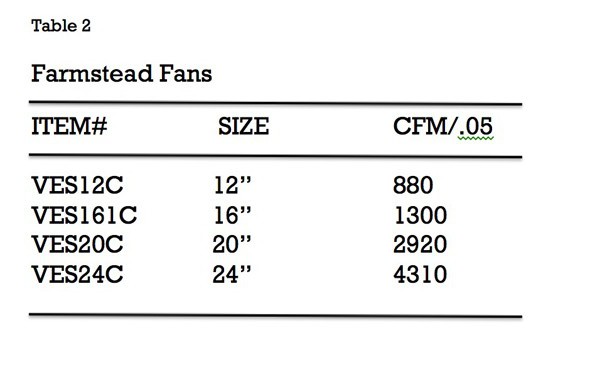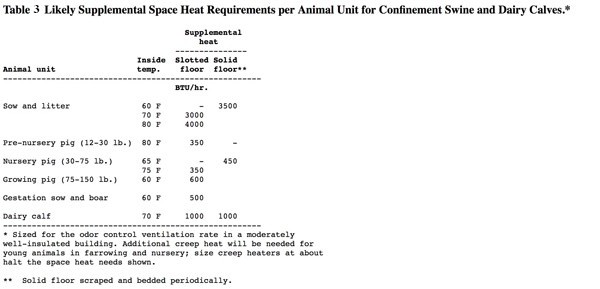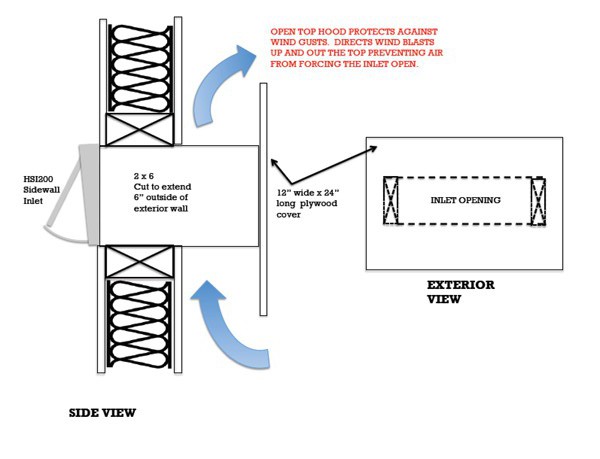Most small-scale producers utilize natural ventilation during warm weather. As the weather cools, regulating the environment inside livestock and poultry buildings becomes more difficult with manually operated vent doors. Adding small ventilation fan(s) simplifies the task of maintaining a healthy environment for the animals.
The first step is to determine the minimum and mild winter rates for the amount of the animals housed. Table 1 displays a chart with recommended ventilation rates taken from an older university manual.  Minimum rates are the recommended ventilation in cfm (cubic feet per minute) needed to control moisture and prevent condensation from forming on interior surfaces. The additional mild winter airflow stops rising temperatures inside the building as the outside temperature increases.
Minimum rates are the recommended ventilation in cfm (cubic feet per minute) needed to control moisture and prevent condensation from forming on interior surfaces. The additional mild winter airflow stops rising temperatures inside the building as the outside temperature increases.
For our example, we'll use a 24' x 30' farrowing house with ten crates.
10 sows/litters x 20 cfm = 200 cfm minimum rate
10 sows/litters x 80 cfm = 800 cfm mild winter rate
As a fan operates, it creates a static pressure difference between the inside and outside of the building measured in water column inches. Pick an exhausted fan for this application according to its stated cfm deliveries at .05" static pressure. (See Farmstead Fans)
 From the list of fans shown in Table 2, the 12" fan is rated at 880 cfms. This cfm rating matches up closely with the mild winter rate in our example. We have two options that will enable us to reduce the cfm delivery down to the minimum rate of 200 cfm.
From the list of fans shown in Table 2, the 12" fan is rated at 880 cfms. This cfm rating matches up closely with the mild winter rate in our example. We have two options that will enable us to reduce the cfm delivery down to the minimum rate of 200 cfm.
We can use an inexpensive variable speed controller to slow the speed of the fan. (see #NE105F) But be aware that a reduction in fan speed does not directly mean the same reduction in cfms. In other words, reducing the fan speed by 50% does not reduce air delivery by 50%. Turning a fan down too slow can also cause the motor to overheat.
A more accurate method of reducing the amount of air exhausted is using a cycle timer. (see HST001) In the example above we would set the on cycle for one minute and off cycle for four minutes.
20 cfm x 10 sows = 200 cfm
200 cfm/ 880 fan cfm = 0.227 x 300 sec (Total Cycle Time) = 68 sec ON or 1 minute
The additional advantage of using a timer is it allows more flexibility for changing animal density. For instance, if our example farrowing barn was half full we could reduce the on cycle to one minute. If we chose to wean the pigs in the crates and leave them there until they weigh 40 lbs., we would be able to increase the on time to two minutes.
120 pigs x 3 cfm = 360 cfms
360 cfm / 880 cfm = 0.409 x 300 sec (Total Timer Cycle ) = 123 sec ON or 2 minutes
Either the speed control or timer can be wired in parallel with a single stage thermostat to override the low setting. As the temperature rises inside the building, the thermostat takes over and runs the fan at full speed. If the inside temperature goes down with the fan running on high the thermostat drops out, and timer takes over, and the building returns to minimum ventilation.
Operating the minimum ventilation during cold weather will mean adding supplemental heat to maintain a comfortable temperature for the animals. Turning the fan down to prevent the heater from running will create damp, smelly air inside the barn. Table 3 lists the likely supplemental heat requirements per animal. These rates assume adequate insulation in the walls and ceiling and minimum air leaks.

Using our example barn again
20 sows/litters x 3000 Btu = 60,000 Btu heater
or
120 nursery pigs x 350 = 42,000 Btu heater.
Also, you will need to provide air intakes matched to the total ventilation capacity of the fans. A simple gravity activated sidewall inlet (see #HSI200) is the best choice for most situations. Inexpensive and easy to install, this simple plastic inlet automatically opens allowing airflow when the fan(s) operate. When the timer shuts the fan off, the plastic louver closes.
Inlets installed in an outside wall require a weather hood to protect against strong winds forcing the louver open. See Weather Hood diagram below. Inlets are typically located opposite the fan(s) to pull air across the building.

Each inlet is rated at 430 cfm. To determine the number of inlets needed divide the total cfm by 430. Using our example
880 cfm/ 430 = 2.04 or 2 inlets needed.
We provided this short article as a guide to adding wintertime ventilation to an existing building. Your individual building will vary by location, the condition of the structure and other factors. For a detailed calculation of the ventilation equipment needed for particular building, please contact us at web.info@hogslat.com.












 Україна
Україна Méjico
Méjico


